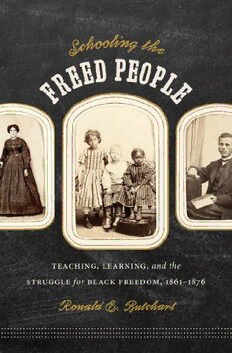
Schooling the Freed People: Teaching, Learning, and the Struggle for Black Freedom, 1861-1876 PDF
Preview Schooling the Freed People: Teaching, Learning, and the Struggle for Black Freedom, 1861-1876
Schooling the Freed People ......................................................................................................................................................... ......................................................................................................................................................... ......................................................................................................................................................... the university of north carolina Chapel Hill Schooling ...................................................................................................................................................... ...................................................................................................................................................... ...................................................................................................................................................... fr eed people the Teaching, Learning, and the Struggle for Black Freedom, 1861–1876 ronald e. butchart ∫ 2010 The University of North Carolina Press All rights reserved Designed by Jacquline Johnson Set in Walbaum MT by Keystone Typesetting, Inc. Manufactured in the United States of America The paper in this book meets the guidelines for permanence and durability of the Committee on Production Guidelines for Book Longevity of the Council on Library Resources. The University of North Carolina Press has been a member of the Green Press Initiative since 2003. Library of Congress Cataloging-in-Publication Data Butchart, Ronald E. Schooling the freed people : teaching, learning, and the struggle for black freedom, 1861–1876 / Ronald E. Butchart. p. cm. Includes bibliographical references and index. isbn 978-0-8078-3420-6 (cloth : alk. paper) 1. Freedmen—Education—Southern States. 2. Education—Southern States— History—19th century. 3. African American teachers—Southern States— History—19th century. 4. Reconstruction (U.S. history, 1865–1877) I. Title. lc2802.s9b874 2010 371.829%960730750934—dc22 2010011936 cloth 14 13 12 11 10 5 4 3 2 1 Contents Preface ix Acknowledgments xxi 1. At the Dawn of Freedom 1 2. To Serve My Own People Black Teachers in the Southern Black Schools 17 3. It Will Result in a Better Understanding of Their Duties Southern White Teachers and the Limits of Emancipation 52 4. A Desire to Labor in the Missionary Cause Northern White Teachers and the Ambiguities of Emancipation 78 5. You Will, of Course, Wish to Know All about Our School Learning and Teaching in the Freed People’s Schools 120 6. Race, Reconstruction, and Redemption The Fate of Emancipation and Education, 1861–1876 153 Appendix A: Teachers in the Freed People’s Schools, 1861–1876 179 Appendix B: Estimating the Number of Black and Southern White Teachers, 1869–1876 184 Notes 189 Bibliography 247 Index 301 This page intentionally left blank Illustrations and Tables Illustrations Students from the Capitol Hill School 9 Isabella Gibbons 24 Joshua E. Wilson 35 James H. Bowser 39 Mrs. Ida S. Marshall 50 Mrs. Eunice Leland 82 Miss Ellen S. Kempton 83 Joshua Stuart Banfield 86 Betsey L. Canedy 98 Jane Briggs Smith 118 Three children in Mary A. Upton’s class 129 A second group of students from the Capitol Hill School 139 Anna Gardner’s school 148 Mary S. Osborne 163 ‘‘Worse than Slavery,’’ by Thomas Nast 173 Tables 1. Teachers of the Freed People by Race and Region of Origin 20 2. Participation Rates of Teachers by Race and Region of Origin, 1861–1876 55 viii 3. Teachers’ Gender and Mean Years of Teaching, 1861–1876, by Region and Race 81 1-A. Gender and Race of All Teachers 180 2-A. Northern Teachers by Race and Gender 181 3-A. Southern Teachers by Race and Gender 182 4-A. Teachers of Foreign Birth by Race and Gender 182 5-A. Mean Years of Teaching in Freedmen’s Schools, 1861–1876 183 6-A. Mean and Median Age at Commencement of Teaching in Freedmen’s Schools 183 1-B. Teachers in South Carolina Schools, 1870–1879, and Estimated Number in South Carolina Black Schools 186 2-B. Proportions of Teachers of Each Race to Total Population of Race in South Carolina, Adjusted Proportions, and Resulting Estimate of Total Southern Teaching Force in Southern Black Schools, 1870–1876 187 Illustrations and Tables Preface If there is one constant in historical writing, it is revision. Each generation of writers brings its own perspectives and troubles to bear on the past, finds new material, and reinterprets old sources. The result is new understand- ings of old stories, new images and portraits, revised pictures of the past. Reconstruction’s history bears dramatic evidence of that process. Attentive readers of that history have moved the earlier images of the actors and processes of Reconstruction to dusty mental storage rooms, replacing them with new, often starkly di√erent images. Reviled villains have been re- drawn as tragic victims; heroic causes have been revealed as ignoble, mur- derous treachery. Yet in one corner of Reconstruction historiography, the history of the schooling of the freed people, interpretations have shifted, but the por- traits of the primary actors have been only lightly retouched after a cen- tury of historical study. Whether their history was captured by W. E. B. Du Bois, by historians in the Dunning tradition, or by revisionists of the last three decades, the foreground of that picture has remained remarkably unchanged. While each historiographic tradition has intended something di√erent by the exact shadings and details of the portrait it rendered, the main figures in the portrait have been largely untouched in the process. W. E. B. Du Bois sketched the most enduring elements of the educators’ image. Describing what he called ‘‘the crusade of the New England school- ma’am,’’ he wrote, ‘‘Behind the mists of ruin and rapine waved the calico dresses of women who dared. Rich and poor they were, serious and curious. Bereaved now of a father, now of a brother, now of more than these, they came seeking a life work in planting New England schoolhouses among the white and black of the South.’’∞ Several of the salient elements of the teachers’ enduring portrait were etched deep in that poetic description: the teachers were New England schoolmarms, a description that implied that
